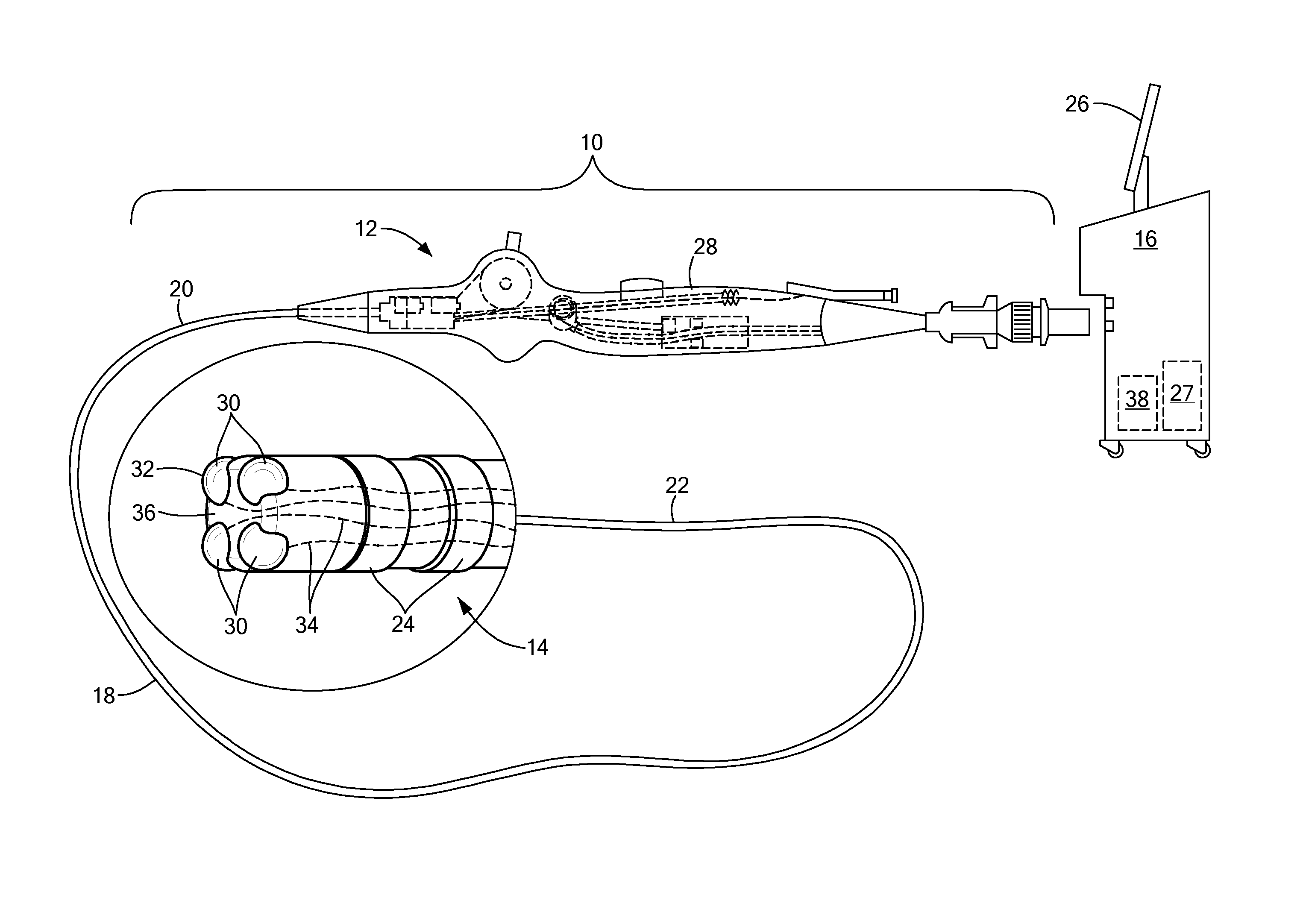Electrophysiology catheter design
a catheter design and electrophysiology technology, applied in the field of electrophysiology catheter design, can solve the problems of inability to accurately and reliably detect the map signal of the cardiac electrophysiology catheter, the electrode is more likely to incur local overheating, and the current known cardiac electrophysiology catheters do not accurately and reliably detect the map signal, etc., to achieve the improvement of mapping and/or ablation of the target tissue region, enhance local small area contact pressure, and reduce manufacturing cost and complexity
- Summary
- Abstract
- Description
- Claims
- Application Information
AI Technical Summary
Benefits of technology
Problems solved by technology
Method used
Image
Examples
first embodiment
[0038]Referring now to FIG. 2, a distal assembly 14 is shown. The distal assembly 14 may include a housing 36 and one or more electrodes 30, such as monophasic action potential (MAP) electrodes, each positioned a radial distance from the longitudinal axis 40 of the housing 36. If two electrodes 30 are used, the electrodes 30 may be positioned opposite each other. If three or more electrodes 30 are used (for example, four electrodes are shown in FIG. 2), the electrodes 30 may have a radial symmetry about the housing longitudinal axis 40.
[0039]The distal assembly 14 shown in FIG. 2 may have been formed according to the method shown and described in FIGS. 3-5. For example, one or more bulbed wires 42 comprising a bulb portion 44 and a wire portion 46 may be created (as shown and described in FIG. 3). The wire 46 portion of each bulbed wire 42 may then be anodized (as shown and described in FIG. 4), and the bulb portion 44 of each bulbed wire 42 may be composed of the non-anodized mater...
third embodiment
[0046]Referring now to FIGS. 6A and 6B, a second and third embodiment of a distal assembly 14 is shown. In both embodiments, the electrode head 32 (the conductive portion) and the electrode wire 34 (the insulated portion) are not only composed of the same material, but are also created from a single piece of material (collectively referred to as an “electrode”). This may reduce manufacturing cost and complexity. Additionally, more than one electrode wires 34 may be used within a catheter body 18 without the need for including insulation material between the wires.
[0047]In the embodiment shown in FIG. 6A, a plurality (for example, three) electrode wires 34 are disposed within a medical device, such as a catheter elongate body 18. Each wire 34 may be composed of a metal (for example, tantalum or TaKS) and include an outer insulative oxide layer (for example, tantalum pentoxide). When low-frequency or DC voltage flows through the wire, the wire 34 will function as an insulated conducto...
fifth embodiment
[0049]Referring now to FIGS. 7A and 7B, a fourth and fifth embodiment of the distal assembly 14 are shown. These embodiments include an electrode 30 that has both mapping and ablation functionality. As shown in FIG. 7A, one or more electrodes 30 may be disposed about the distal portion 22 of a medical device, such as the flexible, elongate body 18 of a catheter. Although FIG. 7A shows two electrodes 30, any number of electrodes 30 may be used. Each electrode 30 may include a conductive region 70 and a region that is selectively conductive 72. As described herein, the electrode 30 may be composed of a highly conductive metal such as gold and may include a thin film coating of a metal such as tantalum, and the selectively conductive region 72 may include an outer oxide layer, whereas the conductive region 70 does not. The oxide layer may be an oxide of aluminum, tungsten, titanium, tantalum, hafnium, niobium, zirconium (and alloys thereof). The oxide layer in the case of tantalum pent...
PUM
 Login to View More
Login to View More Abstract
Description
Claims
Application Information
 Login to View More
Login to View More - R&D
- Intellectual Property
- Life Sciences
- Materials
- Tech Scout
- Unparalleled Data Quality
- Higher Quality Content
- 60% Fewer Hallucinations
Browse by: Latest US Patents, China's latest patents, Technical Efficacy Thesaurus, Application Domain, Technology Topic, Popular Technical Reports.
© 2025 PatSnap. All rights reserved.Legal|Privacy policy|Modern Slavery Act Transparency Statement|Sitemap|About US| Contact US: help@patsnap.com



